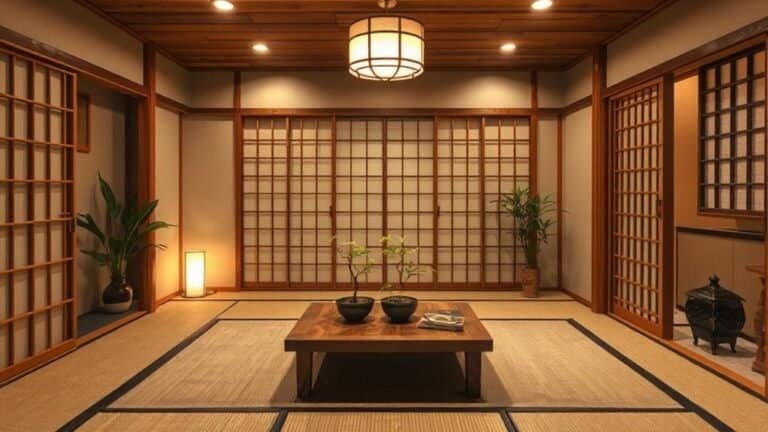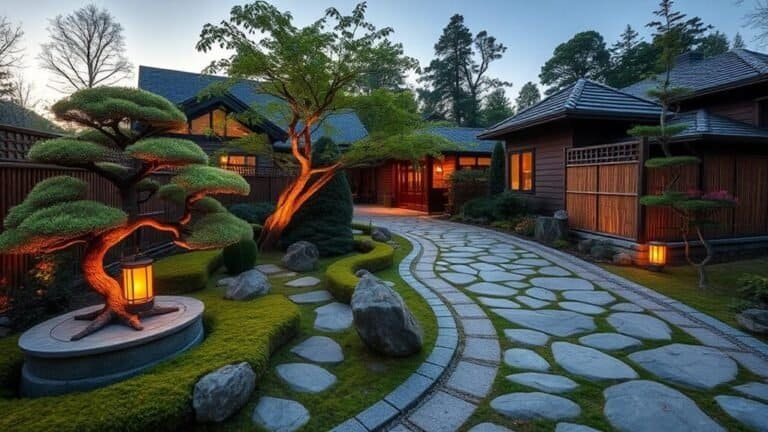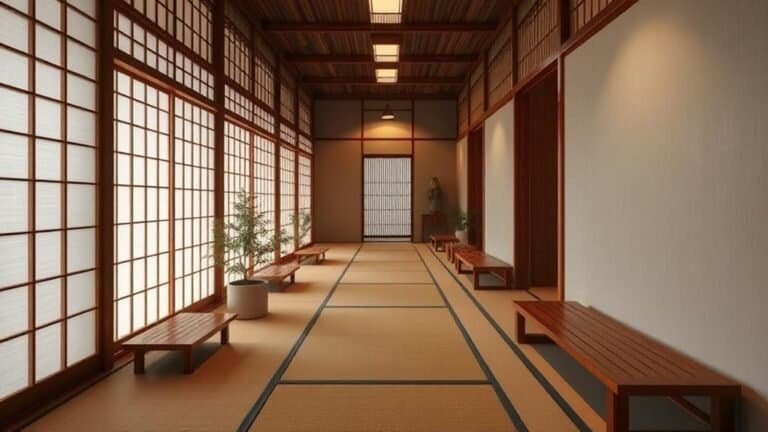Achieving Japanese-style attic decor is all about simplicity and connection to nature. Start by defining your attic's purpose, then select low-profile furniture and maximize natural light. Use a muted color palette with soft greens and earth tones to create a calming atmosphere. Incorporate natural materials like wood and bamboo, and don't forget the charm of shoji screens for added privacy and style. Add cozy elements like cushions and warm lighting to enhance relaxation. By embracing minimalism and intentional design, you'll create a serene retreat. Stay with us to explore more tips that will elevate your space even further!
Key Takeaways
- Define the purpose of your attic space to guide decor choices and furniture arrangement for optimal relaxation and functionality.
- Select a muted color palette with soft earth tones to create a calming atmosphere that reflects nature.
- Incorporate natural materials like wood, bamboo, and stone to enhance the connection to nature and promote tranquility.
- Use low-profile furniture and multi-functional pieces to maintain an open feel and embrace minimalist design principles.
- Add Zen elements such as indoor plants, soft lighting, and soothing sounds to foster a peaceful and cozy ambiance.
Understanding Japanese Aesthetics

When you explore Japanese aesthetics, you'll find a unique blend of simplicity and nature that resonates deeply with the senses. The essence of this style lies in its ability to create harmony through minimalism. You'll notice how every element in Japanese design serves a purpose, inviting tranquility and mindfulness into your space. This approach encourages you to embrace less, allowing for a more profound appreciation of what you have. Consider enhancing your space with Japanese style yard decor that complements the overall theme and brings the beauty of nature closer to your attic.
Start by focusing on natural materials, like wood and stone, which evoke a connection to the environment. You might consider incorporating sliding doors, known as shoji, which not only save space but also bring in soft, diffused light. Choosing a muted color palette can further enhance this calming atmosphere. Think soft whites, earthy browns, and gentle greens.
Don't forget about the importance of open space. Arranging your furniture with intention creates a flow that encourages movement and relaxation. Finally, add personal touches, like a few carefully selected pieces of art or a bonsai tree, to bring life into your attic. By understanding and implementing these principles of Japanese aesthetics, you can transform your attic into a serene escape that inspires creativity and innovation.
Planning Your Attic Space

Creating a thoughtful plan for your attic space is key to achieving the tranquil atmosphere characteristic of Japanese aesthetics. Start by envisioning how you want to use the space. Whether it's a serene reading nook, a cozy meditation area, or a minimalist workspace, defining the purpose will guide your decisions.
Next, consider the layout. Use the following table to help organize your thoughts:
| Element | Considerations |
|---|---|
| Furniture | Choose low-profile pieces |
| Lighting | Natural light is essential |
| Storage | Opt for hidden or built-in options |
| Decor | Incorporate natural materials |
| Plants | Add greenery for tranquility |
Measure your attic dimensions carefully and sketch a rough floor plan. Think about flow and accessibility. Keep pathways clear to maintain an open feel, which is central to Japanese design.
Lastly, don't forget to embrace simplicity. Select only a few meaningful items to display, creating a sense of calm. By thoughtfully planning your attic space, you'll set the stage for a beautifully serene environment that embodies Japanese style. Get excited about transforming your space into a peaceful retreat!
Choosing a Color Palette

A well-chosen color palette can greatly enhance the tranquility of your attic space. When selecting colors, think about the serene beauty of traditional Japanese aesthetics. Soft, muted tones like pale greens, gentle grays, and warm beiges can create a calming atmosphere, making your attic a peaceful retreat. You might also consider incorporating subtle earth tones that reflect nature, fostering a sense of connection with the outdoors. Additionally, integrating elements of Japanese fireplace decor can further enhance the soothing ambiance of your space.
Start by choosing a base color that resonates with you. This color will set the mood for the entire space. Then, select two or three complementary shades to add depth and interest. Remember, Japanese design often emphasizes simplicity and harmony, so avoid overly bright or chaotic colors that might disrupt the serene vibe.
Don't forget about the natural light in your attic. Test your chosen colors at different times of the day to see how they interact with changing light conditions. Finally, consider the emotional impact of your color choices. Each hue can evoke different feelings, so pick shades that inspire relaxation and creativity. With the right palette, your attic can transform into a harmonious haven that reflects your unique style while embodying the tranquility of Japanese design.
Selecting Natural Materials

Often, selecting natural materials is essential for achieving an authentic Japanese aesthetic in your attic decor. You'll want to focus on elements that not only look beautiful but also resonate with nature. Start with wood; opt for light-colored varieties like pine or cedar. These woods bring warmth and a sense of tranquility, perfect for that serene Japanese vibe. Consider incorporating elements from Japanese balcony decor to enhance the ambiance even further.
Next, consider bamboo. It's versatile, eco-friendly, and can be used in various ways, from furniture to decorative accents. You might also want to incorporate natural textiles, such as linen or cotton, in earthy tones. These fabrics add softness and comfort, enhancing the overall ambiance.
Don't forget about stone! Incorporating natural stone elements can ground your space, creating a harmonious balance with wood. Think about using pebbles in decorative features or even a small indoor rock garden.
Incorporating Shoji Screens

Shoji screens are a fantastic way to enhance your attic's Japanese aesthetic while maintaining an open and airy feel. These elegant sliding panels can act as room dividers or decorative accents, providing both privacy and a touch of traditional charm. When choosing your shoji screens, consider designs that incorporate natural materials, such as wood and rice paper, to complement the overall theme of your space. Additionally, you can explore various styles of Japanese garden decor that can inspire your shoji screen selection to guarantee a cohesive look throughout your attic.
You can place them strategically to create cozy nooks or separate areas for relaxation and work. For instance, position a shoji screen between a reading corner and your workspace, preserving the seamless flow while offering a visual break. If you're feeling creative, try DIY options; you can repurpose old wooden frames and lightweight fabric to craft your own unique screens.
Lighting is another key element. By placing a light source behind the screens, you can achieve a beautiful glow that enhances the ambiance. When you thoughtfully integrate shoji screens into your attic decor, you'll not only elevate the aesthetic but also foster a serene atmosphere. So go ahead, embrace this innovative feature to transform your attic into a tranquil Japanese-inspired retreat!
Installing Tatami Mats

Transforming your attic into a Japanese-style haven starts with installing tatami mats, which not only provide comfort but also enhance the authentic aesthetic. These traditional mats, made from rice straw and covered with woven rush grass, instill a sense of tranquility and natural beauty.
Before you begin, measure your attic space to determine how many mats you'll need. It's best to purchase mats that fit snugly, reducing the need for cutting. When laying them down, start in one corner and work your way out, aligning the edges carefully for a seamless look.
Here's a quick comparison of different tatami mats to help you choose the best fit:
| Type of Tatami | Benefits |
|---|---|
| Standard | Cost-effective, durable |
| Premium | Luxurious feel, thicker |
| Eco-Friendly | Sustainable materials |
Once installed, consider adding decorative elements like futons or low-profile furniture to complete the look. With tatami mats in place, your attic will not only feel cozy but will also reflect the serene essence of Japanese design. Enjoy the process and let your creativity shine as you craft your personal oasis!
Embracing Minimalism
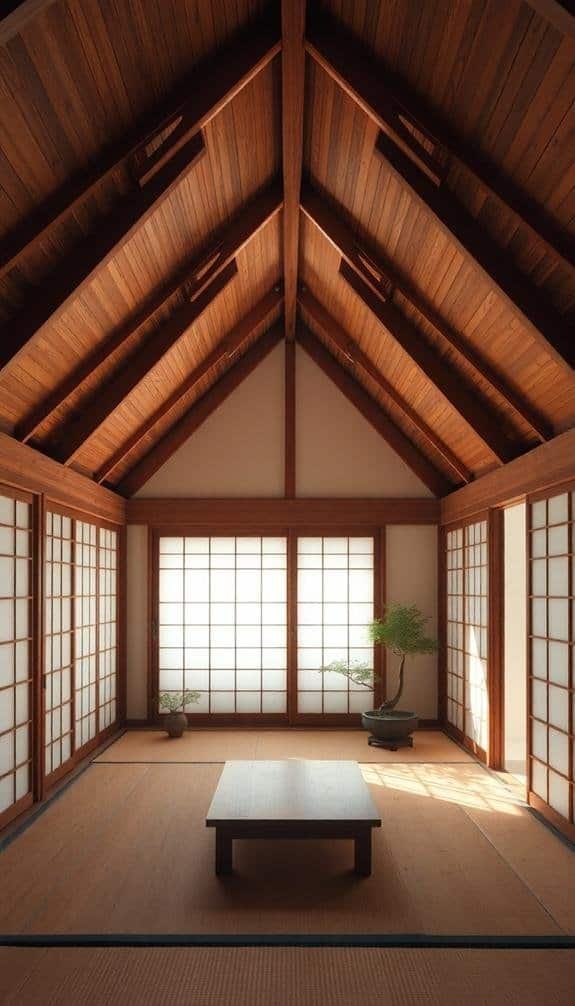
With your tatami mats installed, you can enhance the Japanese aesthetic by embracing minimalism. This design philosophy isn't just about having fewer items; it's about creating a serene space that inspires tranquility and focus. By adopting minimalism, you can transform your attic into a calming retreat. Here are some tips to get you started:
- Declutter ruthlessly: Remove any items that don't serve a purpose or bring you joy.
- Choose multifunctional furniture: Opt for pieces that can serve multiple roles, like a bench with storage.
- Incorporate natural materials: Use wood, stone, and textiles that add warmth without overwhelming the space.
- Limit color palettes: Stick to neutral hues with occasional pops of color for a sophisticated look.
- Prioritize open space: Leave areas empty to allow for movement and create a sense of freedom.
Adding Zen Elements
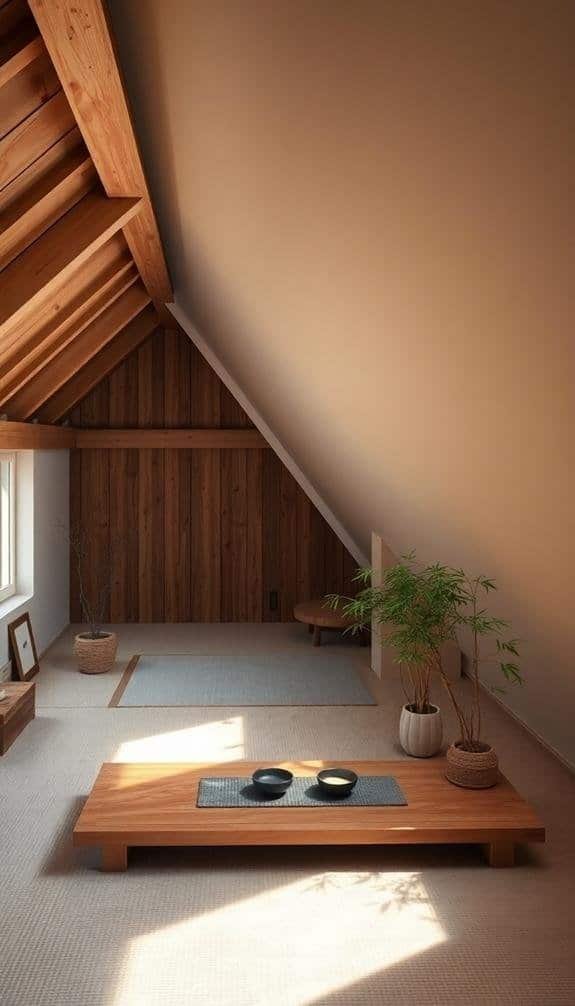
To create a truly calming atmosphere in your attic, adding Zen elements is vital. Start by incorporating natural materials, like bamboo or stone, which resonate with the serene aesthetic of Japanese design. You might consider adding a small indoor water feature, such as a tabletop fountain. The gentle sound of flowing water not only enhances tranquility but also promotes a peaceful ambiance.
Next, think about incorporating plants. Choose low-maintenance options like bonsai or peace lilies; they purify the air and add a touch of nature. Arrange them thoughtfully, allowing for open spaces that encourage a sense of flow.
Lighting also plays a vital role. Opt for soft, warm lighting with paper lanterns or LED strips that mimic natural light. This creates a cozy, inviting space without overwhelming brightness.
Lastly, consider using elements of sound. A wind chime or soft bells can introduce gentle, soothing sounds, enhancing your overall experience. By thoughtfully integrating these Zen elements, you'll cultivate a space that not only looks beautiful but also nourishes your spirit, encouraging relaxation and mindfulness. Embrace these ideas, and watch your attic transform into a serene retreat.
Choosing the Right Furniture
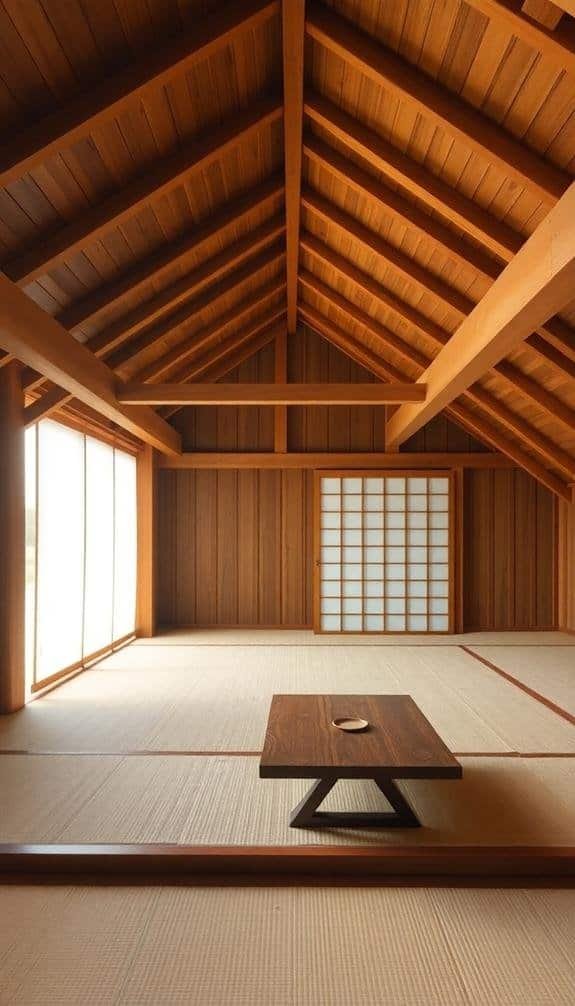
As you cultivate a serene atmosphere with Zen elements, the furniture you choose will greatly impact the overall feel of your attic. Opting for pieces that embody simplicity and functionality will help you achieve that tranquil vibe. Focus on quality over quantity, ensuring each item serves a purpose while contributing to the aesthetic.
Here are some innovative furniture ideas to contemplate:
- Low-profile seating: Think floor cushions or sleek benches that invite relaxation without overpowering the space.
- Natural materials: Choose wood, bamboo, or rattan to create a connection with nature, reinforcing that Zen ambiance.
- Multi-functional pieces: Look for furniture that serves dual purposes, like a storage ottoman or a coffee table that can double as a workspace.
- Minimalist design: Select items that feature clean lines and subtle colors, avoiding overly ornate styles that can disrupt the peaceful vibe.
- Modular elements: Reflect on furniture that can be rearranged to suit different needs, allowing flexibility in how you use your space.
Using Lighting Effectively

Effective lighting plays an essential role in enhancing the serene atmosphere of your attic. To create a calming Japanese-inspired space, consider using a mix of natural and artificial light. Start by harnessing as much natural light as possible. Keep your windows unobstructed, allowing sunlight to flood in during the day. You can enhance this effect with light, sheer curtains that diffuse brightness without blocking it entirely.
For evening ambiance, opt for warm-toned light fixtures. Pendant lights with minimalist designs can add a modern touch while maintaining that serene vibe. Paper lanterns or floor lamps with rice paper shades can also evoke a traditional feel. Position these strategically around your space to create pockets of light that encourage relaxation and focus.
Don't overlook the importance of dimmers. Installing dimmer switches gives you the flexibility to adjust lighting according to your mood or the time of day. Finally, consider accentuating architectural features of your attic with spotlights or LED strips, drawing attention to any unique elements while maintaining an understated elegance. With these lighting strategies, you'll elevate your attic into a tranquil retreat that embodies the essence of Japanese style.
Incorporating Nature
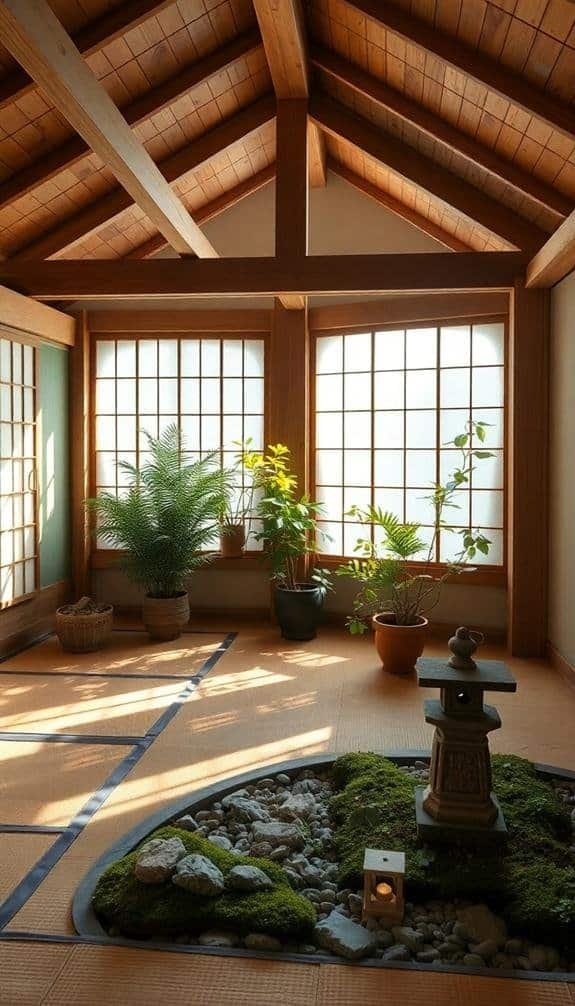
Creating a peaceful atmosphere in your attic isn't just about lighting; incorporating elements of nature can greatly enhance the space's tranquility. By bringing the beauty of the outdoors inside, you'll foster a sense of calm and connection. Here are some innovative ways to achieve that:
- Indoor Plants: Choose low-maintenance varieties like snake plants or succulents to purify the air and add a touch of greenery.
- Natural Materials: Use wood, stone, or bamboo for furniture and decor to create an organic feel that resonates with Japanese aesthetics.
- Water Features: Consider a small tabletop fountain for the soothing sound of flowing water, which promotes relaxation.
- Natural Light: Maximize sunlight with sheer curtains, allowing soft, diffused light to filter in, mimicking the gentle glow of nature.
- Earthy Colors: Paint your walls in muted greens, browns, or soft blues to reflect the colors found in nature, enhancing the serene vibe.
Choosing Artwork and Decor

When it comes to choosing artwork and decor for your Japanese-style attic, simplicity and intentionality are key. Focus on pieces that reflect nature, culture, and tranquility. Think about incorporating minimalist art, such as ink wash paintings or simple calligraphy. These elements can evoke a sense of calm and connection to tradition.
Next, consider the materials. Opt for natural textures—like wood, stone, and linen—that harmonize with your space. Here's a quick reference to inspire your selections:
| Type of Art | Suggested Materials | Ideal Themes |
|---|---|---|
| Paintings | Rice paper, canvas | Nature, Zen |
| Sculptures | Wood, stone | Spirituality, simplicity |
| Textiles | Silk, cotton | Patterns, landscapes |
| Calligraphy | Bamboo, ink | Wisdom, poetry |
| Photography | Recycled materials | Landscapes, simplicity |
Maintaining Simplicity

In a Japanese-style attic, maintaining simplicity is about keeping your space uncluttered and intentional. This approach not only enhances the aesthetic but also promotes tranquility and mindfulness. To achieve this, focus on a few key principles:
- Declutter: Regularly assess your belongings and remove items that don't serve a purpose or bring joy.
- Choose Quality Over Quantity: Invest in fewer, high-quality pieces that reflect your style and personality.
- Embrace Natural Materials: Use wood, stone, or bamboo, which add warmth and texture without overwhelming the senses.
- Limit Color Palette: Stick to neutral tones with occasional pops of color to maintain a serene atmosphere.
- Designate Spaces: Create specific areas for activities, like reading or meditation, promoting functionality without excess.
Creating a Cozy Atmosphere

To warm up your Japanese-style attic, focus on layering textures and incorporating soft lighting that invites relaxation. Start by choosing a warm color palette, like earthy tones or gentle pastels, which can be complemented by natural materials. Think about adding a plush area rug, which not only enhances comfort but also creates visual warmth.
Incorporate cushions and throws in various fabrics, like cotton, linen, and wool, to invite coziness. Don't shy away from mixing patterns, as this adds character while still maintaining that minimalist vibe.
Next, pay attention to lighting. Opt for adjustable lamps or soft string lights that cast a warm glow, perfect for setting a peaceful mood during the evening. You might even consider placing candles in safe areas for added ambiance.
Final Touches for Serenity

Adding the final touches to your Japanese-style attic can truly transform it into a serene retreat. As you refine your space, focus on elements that evoke tranquility and simplicity. Here are some innovative ideas to enhance your attic's ambiance:
- Natural Textures: Incorporate bamboo, rattan, or jute in furniture and decor for an organic feel.
- Soothing Colors: Opt for a palette of soft earth tones, like muted greens and browns, to create a calming environment.
- Minimalist Decor: Keep decor sparse; choose a few meaningful items that resonate with you, allowing for an uncluttered space.
- Lighting: Use warm, soft lighting with paper lanterns or LED candles to mimic the serene glow of traditional Japanese homes.
- Indoor Plants: Add greenery with low-maintenance plants like bonsai or peace lilies to bring nature indoors.


